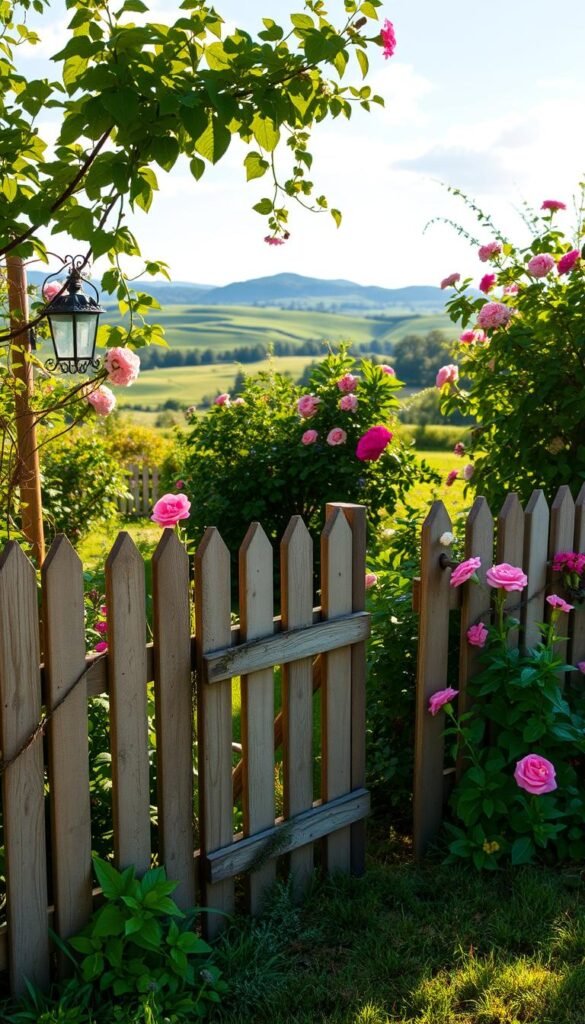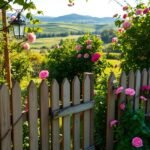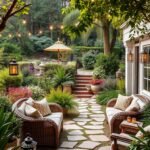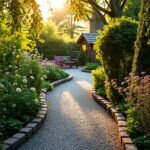Dreaming of an outdoor space that feels like a storybook escape? The right boundary can turn your yard into a cozy retreat that balances beauty with purpose. Whether you’re aiming for classic charm or natural flair, your choices will shape the entire character of your landscape.
Defined edges create magic. They frame flower beds, guide footpaths, and offer support for climbing roses or ivy. You’ll find options that blend seamlessly with nature while adding privacy and structure to your layout.
Traditional styles like crisp white pickets bring timeless appeal, while woven wattle designs add earthy texture. For a rugged touch, weathered wood or iron accents create striking focal points. Each option serves practical needs without sacrificing visual warmth.
This guide walks you through materials, styles, and installation methods—from weekend DIY projects to professional setups. You’ll learn how to match your selection to existing features, soil conditions, and maintenance preferences. Let’s craft those picture-perfect moments your space deserves.
Introduction to Cottage Garden Fences
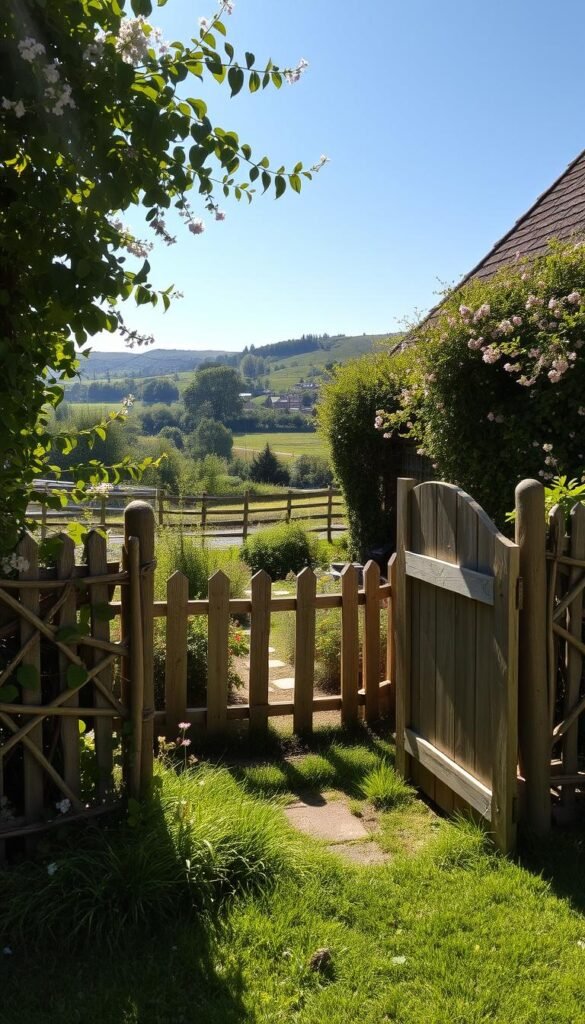
Your outdoor area becomes a sanctuary when boundaries blend beauty with purpose. The right structure does more than outline your space—it shapes how you experience nature’s rhythms. Let’s explore how thoughtful design choices create harmony between wild growth and intentional layouts.
Where Nature Meets Structure
Picture a landscape where loose blooms tumble beside crisp edges. This balance defines cottage-style spaces. Informal flower beds gain clarity when paired with structured borders, letting each element shine without chaos. Vertical supports for climbing vines add depth while softening hard lines.
The Backbone of Your Outdoor Oasis
Boundaries protect delicate blooms from curious critters and harsh winds. They also carve out intimate zones—a reading nook here, a herb corner there. Smart layouts use height variations to guide views without blocking sunlight. Materials matter too: breathable designs let air circulate, keeping plants healthy.
Ever noticed how a weathered wooden frame makes roses pop? Textured surfaces add character while serving practical needs. Your choices influence microclimates, helping shade-loving ferns and sun-hungry daisies thrive side by side. It’s where practicality meets poetry.
Exploring Classic Picket Fence Designs
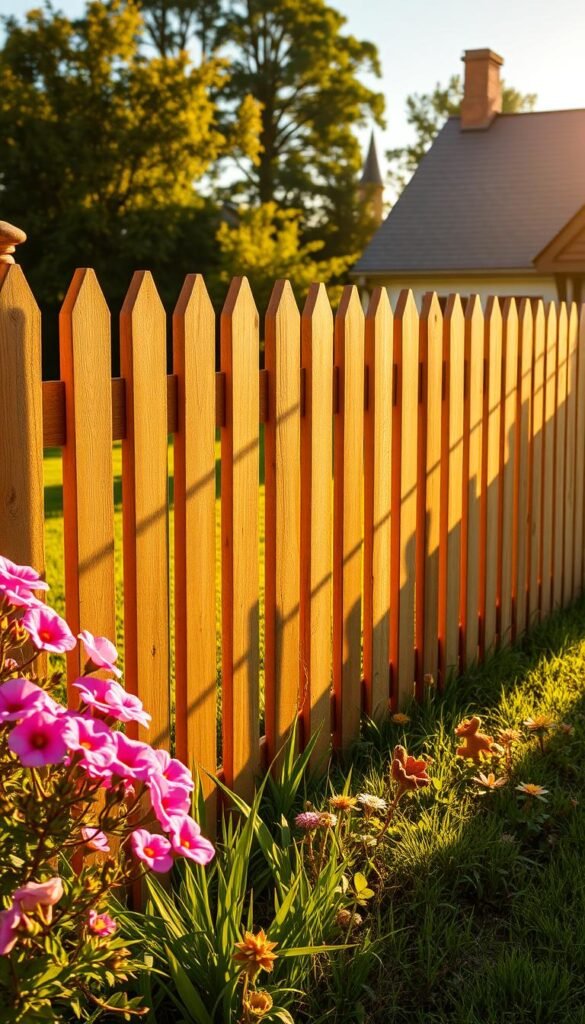
A picket fence isn’t just a boundary—it’s a canvas for your outdoor creativity. These iconic structures bring crisp definition to landscapes while letting sunlight filter through, making them ideal for framing flower beds or lining pathways. Their enduring popularity stems from adaptability: whether you’re crafting a quaint perimeter or dividing garden zones, they deliver both function and charm.
Traditional Appeal and Versatility
The classic white version remains a favorite for good reason. Its clean lines act as a neutral backdrop, allowing colorful blooms like roses or hydrangeas to shine. But today’s options go beyond plain panels. You can choose scalloped tops for whimsy, varied slat spacing for rhythm, or even stained wood for a warmer rustic-meets-refined aesthetic.
Height matters too. Shorter designs (24-36 inches) keep views open, while taller versions (up to 48 inches) offer subtle privacy. Pair yours with an arched gateway draped in clematis or honeysuckle for a cottagecore aesthetic that feels straight from a storybook.
DIY Tips for a Flawless Picket Look
Start by marking your layout with stakes and string—this ensures straight lines. Pressure-treated pine resists rot, but cedar lasts longer outdoors. Pre-painted panels save time, though brushing on exterior-grade paint yourself allows custom hues.
Space slats 2-3 inches apart for balance. Use a spacer block during installation to maintain consistency. Anchor posts in concrete below the frost line to prevent shifting. “A well-built picket fence should survive decades,” notes one landscaper. “It’s worth investing in quality materials upfront.”
At $15-$25 per linear foot, this project offers lasting value. With proper care—like annual touch-ups and clearing debris—your timeless investment will age gracefully, blending structure with nature’s softness.
Rustic Wooden Fence Inspirations and DIY Ideas
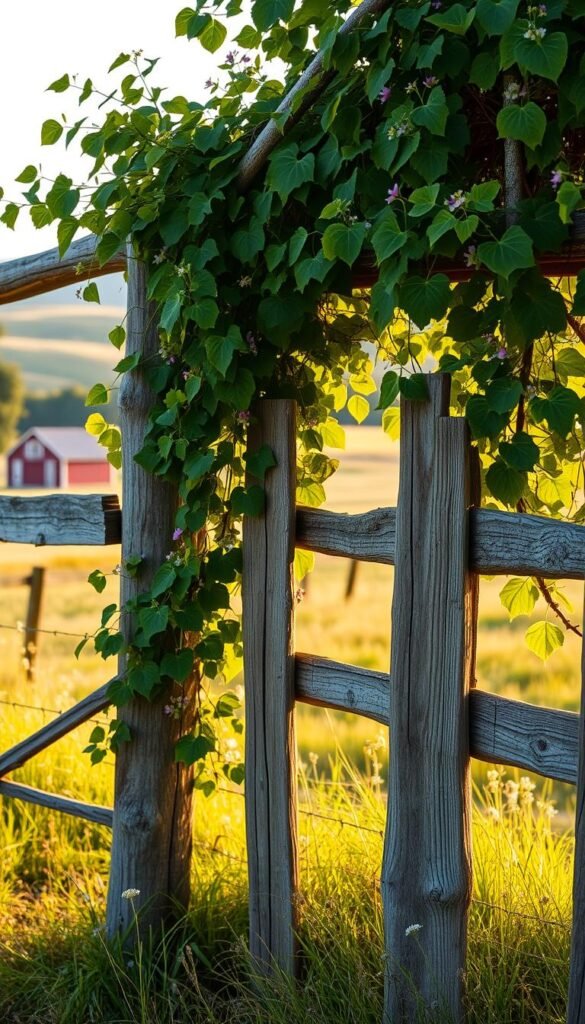
Transform your yard with a fence that tells a story through every knot and weathered groove. Reclaimed timber brings instant history to your space, offering textures no new lumber can match. These structures blend rugged charm with affordability, letting you craft visual interest while staying eco-conscious.
Using Reclaimed Wood for a Weathered Look
Salvaged barn boards or aged fence posts deliver instant character. Their cracks and nail holes become design features, not flaws. One carpenter notes: “Each imperfection whispers about decades of sun, rain, and stories.” Mix board widths for organic appeal, leaving small gaps for ivy or morning glories to climb.
Source materials from local demolition sites or salvage yards—you’ll often pay $5-$15 per linear foot. Pressure-wash gently to preserve patina, then seal with clear weatherproofing. This approach skips artificial aging methods while protecting your budget-friendly investment.
Easy Maintenance and Upgrade Tips
Preserve the rustic vibe with annual inspections and spot repairs. Use tinted sealants on sun-bleached areas rather than full repainting. Add metal brackets or carved details for personality without overwhelming the natural aesthetic.
Rotate sections every few years to equalize weathering. For quick upgrades, attach hanging planters or solar lanterns using reclaimed hardware. These touches keep your DIY project looking lived-in yet intentional, mirroring nature’s effortless beauty.
Cottage Garden Fence Inspiration: Picket, Wattle, and Rustic Gateways
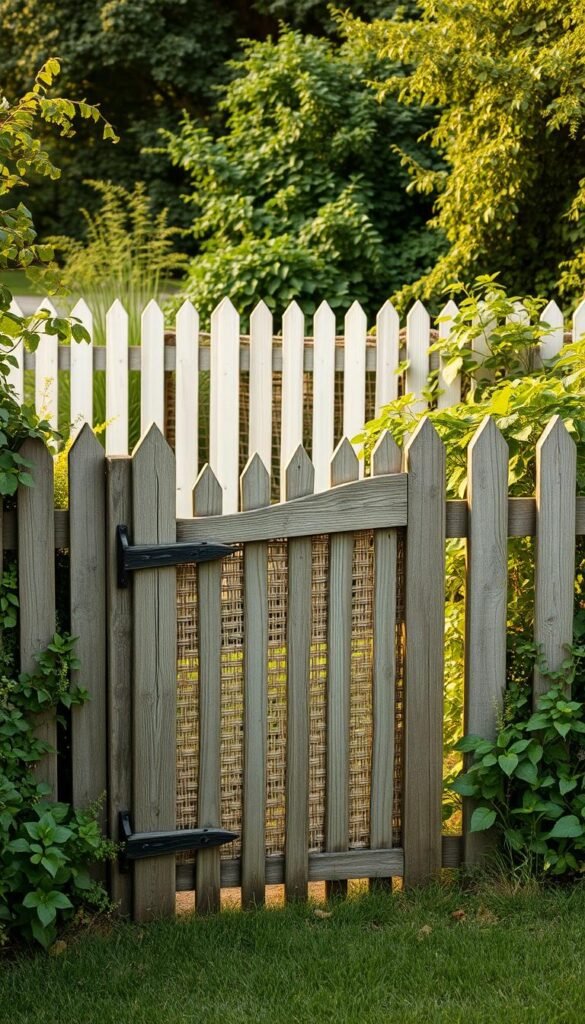
Your landscape becomes a curated masterpiece when structure and nature collaborate. Thoughtful boundaries shape experiences while solving practical needs, proving beauty and purpose aren’t mutually exclusive.
Where Form Meets Practical Magic
Mixing materials creates visual rhythm. Pair crisp white pickets with rugged split-rail sections to define zones without harsh divides. Pro tip: Use matching post caps or stain colors to unify different styles.
Gateways demand attention. An arched entrance with climbing roses says “welcome,” while handcrafted iron hinges on a reclaimed wood gate whisper rustic elegance. “Your entryway should hint at the surprises waiting beyond,” suggests landscape designer Mara Hooper.
| Style | Best For | Plant Partners | Maintenance Level |
|---|---|---|---|
| Picket | Front borders | Roses, clematis | Moderate |
| Wattle | Herb gardens | Thyme, nasturtiums | Low |
| Rustic | Backyard zones | Ivy, morning glories | Minimal |
Built-in planter boxes turn barriers into blooming features. Train jasmine along lattice panels for scent and privacy. Keep sightlines open with lower sections near seating areas—you’ll feel enclosed yet connected to the wider space.
Scale matters most. A 4-foot height balances enclosure and airflow, while narrow 2-foot dividers separate flower beds without crowding. Your choices should frame nature’s artwork, never compete with it.
Innovative Wattle and Lattice Fence Styles
Blend time-honored craftsmanship with contemporary flair using designs that marry texture and function. These structures turn ordinary boundaries into living art pieces, offering both screening and creative plant displays.
Supporting Climbing Plants and Visual Interest
Wattle fencing revives ancient weaving techniques using flexible willow or hazel branches. This eco-friendly approach creates airy barriers that harmonize with wildflower beds. One landscaper notes: “The organic curves of woven designs feel like nature itself shaped the structure.”
Modern lattice panels take this concept further with precise crisscross patterns. Their geometric lines offer sturdy vertical support for heavy bloomers like roses. You’ll love how morning light filters through the openings, casting delicate shadows across your pathways.
Choose between wood’s warm authenticity or vinyl’s weather resistance. Pre-built sections ($15-$25 per foot) simplify installation—just secure posts and attach panels. Leave 1-inch gaps between boards for vine tendrils to weave through naturally.
Maintenance tips? Stain wooden lattice every 3 years to prevent warping. Vinyl options need only occasional rinsing. Both styles create layered visual interest as seasons change: bare branches in winter, lush greenery by summer.
Combining Wood, Stone, and Metal for Unique Fencing
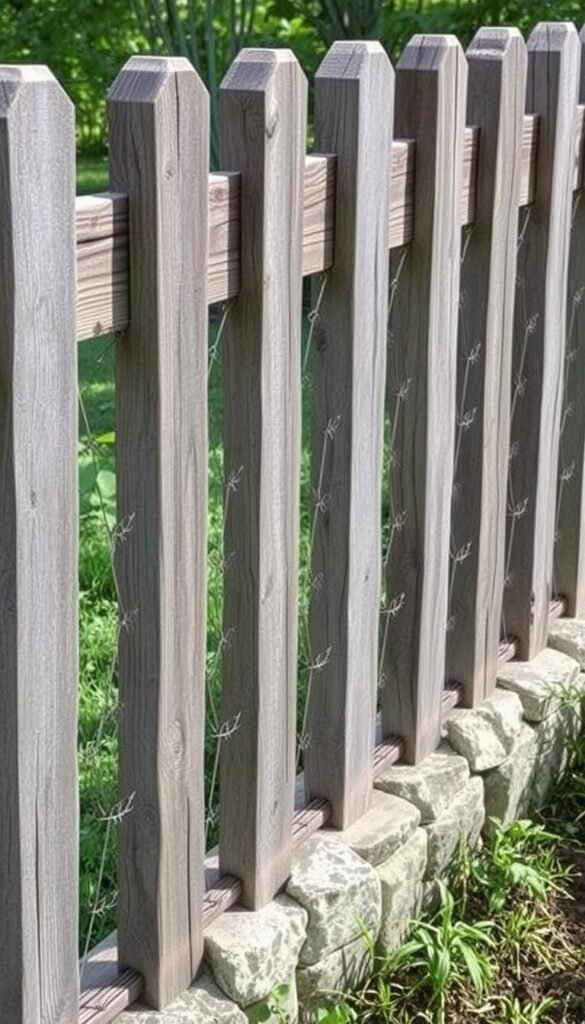
Your outdoor space deserves a boundary that reflects your creativity through bold material combinations. Mixing wood, stone, and metal transforms ordinary barriers into architectural statements that harmonize strength with artistry. These layered designs add depth to your landscape while solving practical needs like durability and zoning.
Mixing Materials for a Dynamic Design
Pair rough-cut stone bases with smooth cedar panels to create contrast that catches the eye. Wrought iron accents introduce elegance, especially when shaped into scrolling patterns between posts. One designer notes: “Metalwork adds permanence, while wood softens the overall feel—it’s yin and yang for your yard.”
| Material Combo | Visual Impact | Cost Per Foot | Lifespan |
|---|---|---|---|
| Stone + Wood | Rustic elegance | $40-$55 | 25+ years |
| Metal + Timber | Industrial warmth | $35-$50 | 30+ years |
| Wrought Iron + Stone | Classic grandeur | $50-$60 | 40+ years |
Installation Insights from the Pros
Use stone pillars as anchors for wood or metal sections—their weight prevents shifting during freeze-thaw cycles. Leave 1/4-inch gaps between dissimilar materials to accommodate expansion. “Always separate metal and wood with rubber spacers,” advises contractor Luis Rivera. “This prevents moisture transfer and corrosion.”
For elevating your space, consider powder-coated steel frames with reclaimed oak infills. Though pricier ($45-$60 per foot), these hybrids withstand harsh weather while aging beautifully. Your investment becomes a legacy feature that grows more character-filled each year.
Modern Black Fence and Contemporary Inspirations
Elevate your outdoor space with boundaries that marry bold simplicity and timeless function. Sleek black fencing offers a fresh take on classic landscapes, creating striking contrasts that highlight your plantings while delivering reliable protection.
Adding a Sleek, Modern Twist
Dark finishes transform ordinary barriers into design statements. Pair matte black panels with vibrant blooms like zinnias or sunflowers—their colors intensify against the neutral backdrop. For vegetable plots, powder-coated steel mesh keeps deer at bay while maintaining a polished look.
One landscape architect shares: “Black acts as a frame, directing attention to what grows around it. It’s the quiet hero of modern gardens.” This approach works wonders in tight spaces too. Narrow vertical slats add height without bulk, perfect for urban yards.
| Material | Best Use | Maintenance | Cost Per Foot |
|---|---|---|---|
| Powder-Coated Steel | Vegetable plots | Annual rinse | $28-$40 |
| Stained Cedar | Flower borders | Reseal every 4 years | $22-$35 |
| Vinyl Composite | Pool areas | Wipe with damp cloth | $18-$30 |
Softening sharp lines is easy. Train sweet peas or moonflowers along lower sections. Their delicate tendrils add whimsy without overwhelming the contemporary style. For year-round interest, install matching black trellises nearby.
Maintenance stays minimal—most options need only occasional cleaning. Choose UV-resistant finishes to prevent fading. Your sleek boundary becomes a lasting foundation that adapts as your plant palette evolves.
Bamboo and Natural Material Fencing Trends
Looking for boundaries that grow with your values? Natural materials like bamboo offer earth-conscious solutions without compromising style. These options blend seamlessly into landscapes while supporting sustainable practices.
Eco-Friendly Boundaries That Breathe
Bamboo fencing stands out for its rapid renewability—some species grow 3 feet daily! Pre-rolled panels from retailers like Wayfair start at $244, offering instant privacy screens. Custom trellis systems cost $20-$35 per linear foot, perfect for defining garden zones or supporting climbing plants.
Though durable, bamboo needs moisture treatments every 2-3 years. Its hollow stems allow airflow, preventing mold in humid areas. Pair with DIY trellises for vertical gardening that feels cohesive.
Golden hues and organic textures soften modern landscapes. Unlike solid wood, spaced bamboo slats filter light beautifully. You’ll create intimate nooks without gloomy shadows—ideal for reading corners or meditation spots.
Choose responsibly sourced materials certified by organizations like FSC. Your eco-friendly fence becomes a statement of care for both your space and the planet.

